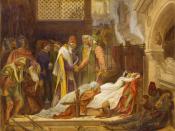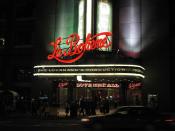In Act I, scene i of Shakespeare's Romeo & Juliet, a fight breaks out between the Montagues and the Capulets. Both Franco Zeffirelli and Baz Luhrmann use this first scene to comment on and set the tone for their films.
My original thoughts after viewing and comparing both directors' versions of the scene was that both directors chose to depict this first scene as a kind of 'bravado gone bad,' but for each director, this means something different.
For Zeffirelli, whether it be the skirmishes between the young men of lower ranks or the battle between Tybalt and Mercutio, the actors bait each other half-kiddingly, each trying to out-macho the other. It is victory by humiliation, and Zeffirelli's boys have no real intention to kill. They use their swords to tease, and do not appear to have a bloody conflict in mind. They are always testing and pushing the limits of bravado, until it goes bad and someone gets hurt.
It is always a shock when bravado does go bad because neither party was expecting to be harmed.
In Luhrmann's film, his boys try to use bravado, but it doesn't work. His boys try to be brave, and show off, but there is always a sense that these boys are really just scared inside. The underlying message is that it doesn't matter how brave his boys are, they will end up getting hurt anyway. Both parties enter the conflict knowing that they will get hurt. Bravado goes bad and tragedy cannot be avoided.
After a careful viewing of both scenes again, I found that I was able not only to prove my hypothesis, but also to add to it. Both directors' use of color in this first scene is used to make a statement about the world around the characters,



Well done
very impressive
0 out of 0 people found this comment useful.